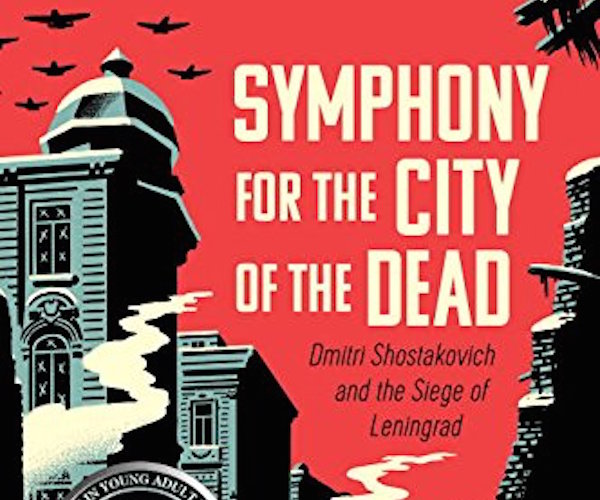Book Review: “Symphony for the City of the Dead” — On Art and Human Survival
M. T. Anderson writes with a compellingly dark tone and a keen eye for characterization worthy of adult readership.
Symphony for the City of the Dead by M.T. Anderson. Candlewick Press, 464 pages, $25.99.

By Matt Hanson
The Siege of Leningrad deserves to be remembered for many reasons, perhaps the best reason is an unexpectedly inspiring one: in the middle of unfathomable wreckage and horror, the starving city rallied with a literally death-defying performance of Shostakovich’s Seventh Symphony. M.T. Anderson’s novelistic history Symphony For the City of the Dead tells the story of the siege of Leningrad and the heroic efforts of one of its native sons to keep it alive.
M.T. Anderson is Cambridge-based author of several acclaimed novels, including Feed and the Octavian Nothing series, which are classified as young adult fiction but are much more than kid’s stuff. Anderson writes with a compellingly dark tone and a keen eye for characterization worthy of adult readership. Symphony marks Anderson’s first attempt at writing history, and he brings every bit of his novelist’s skill to the narrative, making the bleak world of Leningrad during the siege harrowingly vivid and compulsively readable.
After Hitler broke his pact with Stalin and rashly chose to invade the Russian front, much of the country was caught off balance. Leningrad, a cultured and elegant city, suffered one horrendous tragedy after another. All the odds were against the likelihood of Leningrad’s survival: the Nazi army attempting to throttle the northern city into submission by means of the siege, Stalin’s initial indifference on account of the longer, bloodier battle to defend Stalingrad, his myopia as a military planner, and the fact that the city’s supply of food and raw materials was blown to smithereens early on, causing an eerily beautiful explosion in the sky.
Anderson pays close attention to the seething, truly Kafkaesque policies of Stalinism, particularly for the artists and composers forced to live under censorship and constant scrutiny. A culture of paranoia and dread reigned supreme, where every word and deed was susceptible to being used as grounds for arrest and subsequent torture and/or execution. Family members spied on each other, going through their daily lives with forced smiles so as not to appear critical or disapproving of the power-that-be, lest the secret police start asking questions.
After Stalin stormed out of a badly orchestrated performance of Shostakovich’s opera Lady Macbeth of Mtsensk, ominous editorials began appearing in the government-backed newspaper Pravda claiming that the anxious young composer might be guilty of the crime of so-called “formalism” and ought to watch his back. Shostakovich was subsequently called in to “the Big House” for questioning. Spending hours protesting his innocence, the interrogator told him to “think harder” and come back the following Monday, which the composer knew would be a death sentence. After an anguished weekend saying his final goodbyes to his wife and family, Shostakovich kept the appointment only to wait for hours in the lobby until he discovered after breathlessly inquiring that his interrogator had been arrested the day before and to please accept the state’s apology for the inconvenience.
Dimitri Shostakovich (who would be perfectly played by James Urbaniak in a biopic) was one of the leading composers of Leningrad’s vibrant music scene. His intensity and humble perfectionism established him early as a talent to watch, even though he ambivalently collaborated with some of the most revolutionary of the avant-garde artists of the time, such as the unhinged radical poet Vladimir Mayakovsky. Shostakovich’s music is sensitively and evocatively described, with a particular eye for the composer’s versatility and dry-eyed lyricism.
Life in Leningrad under the siege became progressively cheaper as the weeks of deprivation turned into months and years of people dropping dead in the street from exhaustion. Desperate families resorted to making soup out of wallpaper glue, boiling pieces of leather and butchering family pets. The city needed a rallying point and managed to find hope in music. Despite his hesitance to leave his city, Shostakovich had managed to escape to Moscow. There he finally finished the new piece he’d been working on in the midst of the chaos. It was smuggled back to a ravaged and dwindling population desperate for something to give them a reason to keep living.
Against all odds, Shostakovich’s Seventh Symphony was performed by a ragged assembly of Leningrad musicians who were quite literally starving to death, many of whom were barely able to hold up their instruments. The conductor’s hand trembled as he waved his baton. The symphony, a rousing and unsentimental masterpiece, was broadcast as a gesture of encouragement to the devastated people of Leningrad, an act of defiance aimed at the surrounding Nazi army, whose gunfire was echoed in the rhythms of the music itself. The sound of the advancing German army is represented in motifs that repeat, growing more and more intense, leading to a finish that is powerful but ironically not triumphalist, as the era’s official demand for patriotic aesthetics demanded.
Considering how much was at stake politically, emotionally and militarily for all involved, the performance of the Seventh Symphony should rank highly on the list of greatest musical performances of the 20th Century. In Symphony for the City of the Dead, M.T. Anderson has brought his considerable novelistic skills to re-tell an engrossing piece of history that needs to be remembered, not only by lovers of classical music but by anyone who is interested in the reciprocal (and visceral) relationship between art and human survival.
Matt Hanson is a critic for The Arts Fuse living outside Boston. His writing has appeared in The Millions, 3QuarksDaily, and Flak Magazine (RIP), where he was a staff writer. He blogs about movies and culture for LoveMoneyClothes. His poetry chapbook was published by Rhinologic Press.
Tagged: Candlewick Press, M.T. Anderson, Matt Hanson, Symphony for the City of the Dead
